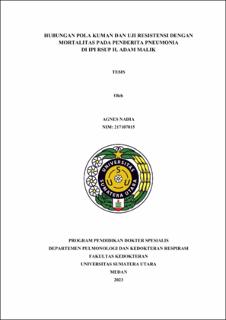| dc.description.abstract | Background and Objectives: The mortality rate in hospitals among intensive care patients is 20-30%, and ICU patients contribute to 20-50% of all hospital deaths. Mortality in the ICU is high, but the risk increases further when accompanied by nosocomial infections. Therefore, it is crucial to detect infections, especially in the lower respiratory tract, through examinations such as BAL, which is useful for mapping the microbial patterns in hospitals, thereby ensuring the precise use of antibiotics to reduce mortality. Based on the aforementioned background, there appears to be a relationship between microbial patterns and mortality. However, the association between microbial patterns and mortality based on BAL examinations is limited, prompting researchers to conduct a study on the "Relationship between microbial patterns and resistance testing with mortality based on BAL examinations in inpatient pneumonia cases in the ICU."
Method: This research uses a quantitative method with a cross-sectional study design to examine the relationship between microbial patterns and resistance testing with mortality.
Results: Based on the research findings, the mortality rate of pneumonia patients in the ICU at RSU H. Adam Malik is 17 cases (37%). The highest category of pneumonia patients is classified as CAP (Community Acquired Pneumonia), with 18 cases (39.1%), and the lowest category is VAP (Ventilator Associated Pneumonia), with 11 cases (23.9%). There is no relationship between drug resistance and mortality in pneumonia patients in the ICU in H. Adam Malik General Hospital. There is no relationship between microbial patterns and mortality in pneumonia patients in the ICU of H. Adam Malik General Hospital. | en_US |


